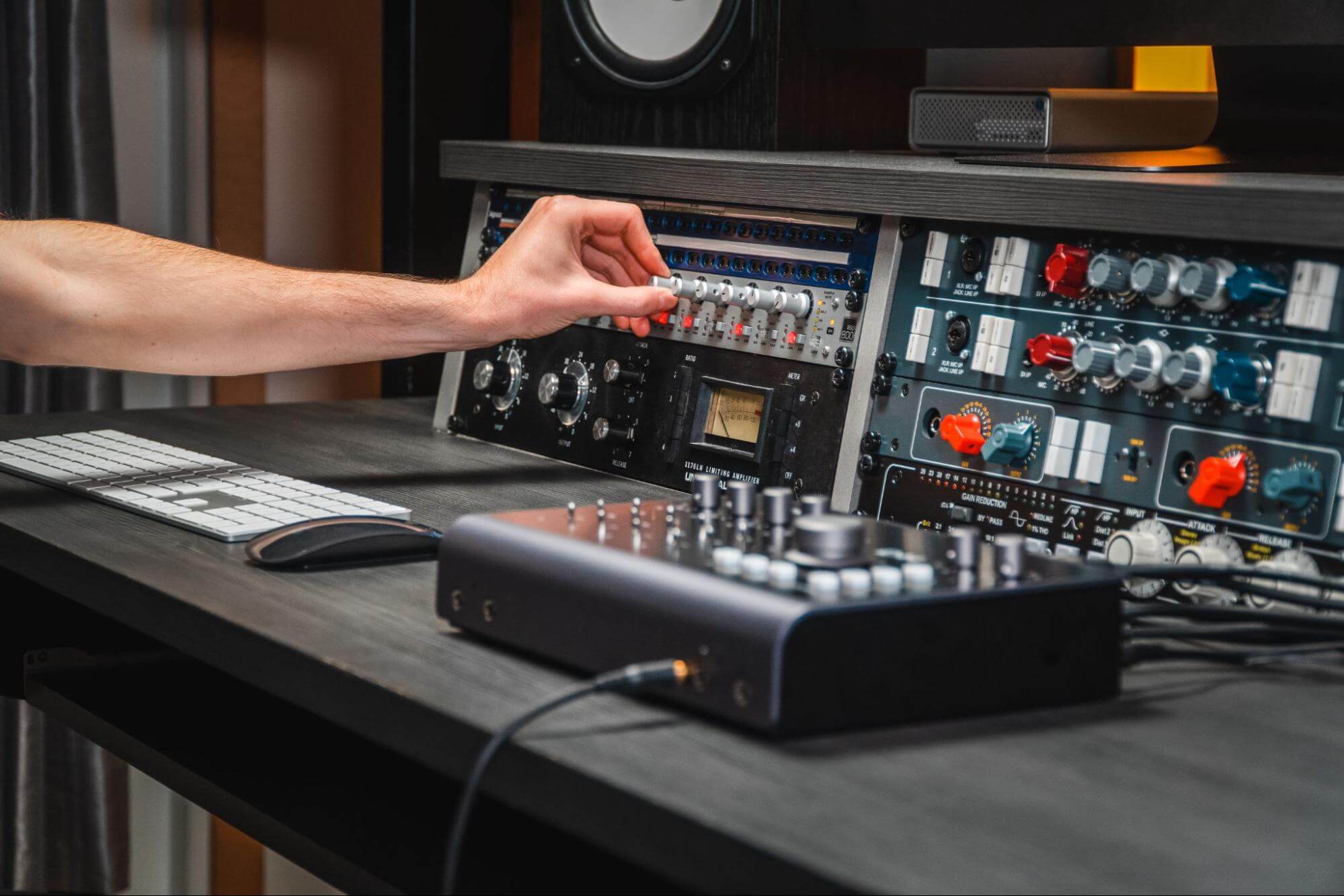For those of you who aren’t aware, Palm Reader are one of the UKs most underrated, heavier Hardcore Punk / Metal bands. They haven’t exactly had the easiest of careers as a band but they have never given in or let anything get the better of them. Three full length records down, they recently released their fourth full length LP “Sleepless” via Church Road Records. Available digitally on all streaming platforms, 12” Vinyl and CD.
Of course, like everyone other artist/band, 2020 has been more than tough for Palm Reader and with the release of their new album and no way to promote it with live shows, they took it upon themselves to create a visual, sonic spectacle to rival all the others that they had seen throughout global lockdowns. The guys asked whether I’d be up for capturing, mixing and mastering the audio for this project and I of course welcomed the offer with open arms.
The session took place over two days at St Edmunds Church in Rochdale, Greater Manchester. After extensive virtual meetings, myself, the Director Sam Lees and the rest of the crew decided that having the additional day would be the best way to tackle any potential issues. Due to not being able to run full production rehearsals until the weekend of the shoot it was important for us that we had enough time to go through everything in situ to iron out any kinks. We spent the entirety of Saturday setting up and running through everything making sure the band had their monitor feeds correct and I was capturing what I needed etc so that on Sunday morning we could just walk in and get started.
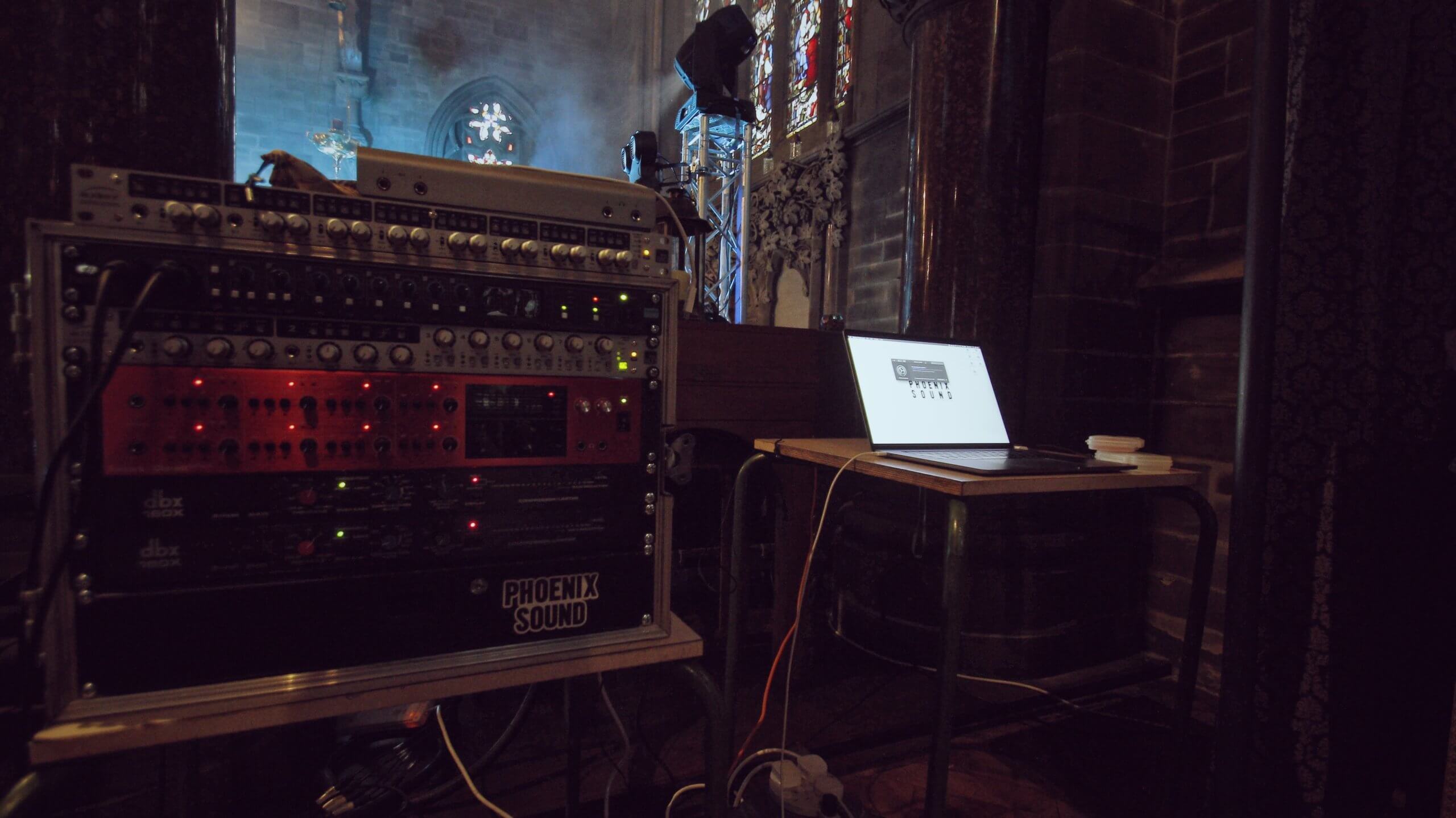
In order to keep things as problem free as possible, I made the audio set up as simple as possible without compromising on any quality.
I rented a 48 Channel Stage Splitter so that both myself and Lewis (Monitor Engineer) had our own feeds to work with. This was so both Lewis and myself could handle our own gain staging and Lewis could mix his monitors without affectingany of my feeds.
We ran the backline directly into the stage split and then took our independent feeds from there.
The bands set up was as follows:
– Drums
– Bass (Amp & DI)
– Guitar L (2x Amp & 1x DI)
– Guitar Center (Amp & DI)
– Guitar R (Amp & DI)
– Keys / Modular Synths (L/R DI)
– Lead Vocals
– Backing Vocals (x3)
– Rooms Stereo 2x
– Room Omni x1
With a total channel count of 27. Audient were good enough to send me another ASP880 for this session in order for me to expand my channel capabilities to handle the session.
My rig consisted of my Clarett 8PreX which was hooked into my ASP800 and Octopre Mkii. These three units were connected and synced via ADAT and Wordclock giving me a channel count of 24, I then ran my Audient ID44 with the additional ASP880 Synced via ADAT & Wordclock which once clocked together with the Focusrite units and ASP800 by creating an aggregate device on my Mac gave me a total channel count of 36. This left me with plenty of room to play with if I needed / wanted to add any additional microphones / DIs.
I have made a crude little diagram of this setup so you can understand it better. See below:
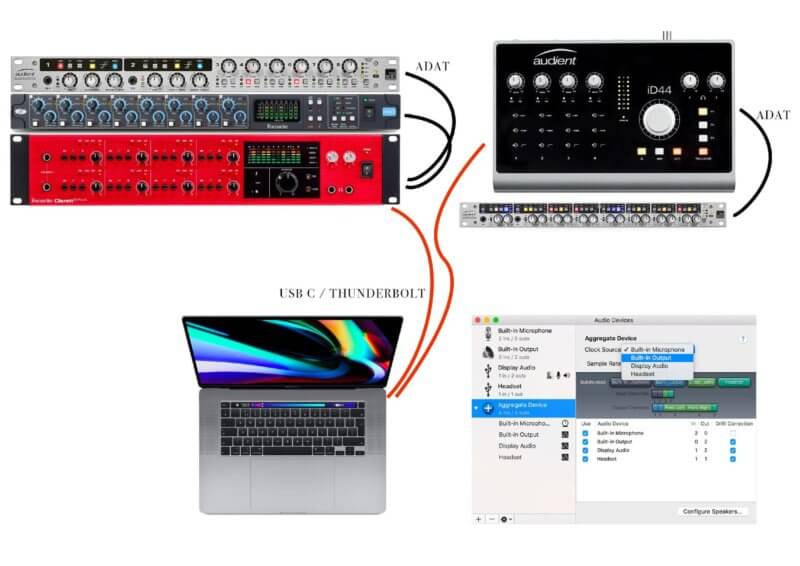
In terms of the on stage setup I spent a while going back and forth between having amps live on stage or whether to just take DI’s and not have the amps live then re-amp when I was back in the studio in order to reduce the amount of spill and wash. Recording in a venue like a large empty church poses a lot of problems when it comes to clarity and spill so I wanted to try and reduce this as much as possible to make my life easier when it came to mixing the session. I ended up settling on having the amps live but just quiet in the room. I decided to do this when I decided I wanted to use additional room mics. I didn’t want the room mics to not give an accurate representation of the energy coming off the stage by only having the drums in them. So I took DI signals from the end of the guys pedalboards as well as having the amps live. Typically if I was taking DIs for re-amping I would take them before any effects pedals so I had complete control over the re-amping stage but because this was live and I needed what was coming out of the amps into the room mics to match with whatever got re-amped I needed to make sure that all the guys effects processing was maintained on the DI signal. The final mix is a blend of re-amped DI signals and original on the day live audio straight from the speaker cabinets. Since all the performers were on in-ear monitors, they were able to have clear and detailed monitoring fed directly to them, which meant I was able to run a quieter stage and pose no issue to their performance.
Micing wise I have attached a table of how things were mic’d and below that there is a short walk-through of the positions and how the mics were used.
| Instrument | Mic |
| Kick In | Shure Beta 91a |
| Kick Out | Audix D6 |
| Snare Top | Beyerdynamic M201 |
| Snare Bottom | Sennheiser E604 |
| Rack | Aston Starlight |
| Floor | Audix D6 |
| Hi Hat | Shure SM81 |
| OH L | SE Electronics 5 |
| OH R | SE Electronics 5 |
| GTR L (Vox) | Shure SM57 |
| GTR L (Sunn) | Sennheiser M421 |
| GTR DI | DI |
| GTR C (Orange) | Shure SM57 |
| GTR DI | DI |
| GTR R (Orange) | Shure SM57 |
| GTR DI | DI |
| Bass Amp (Orange) | Shure Beta 52a |
| Bass DI | Darkglass Electronics B7K Ultra |
| Modular Synth (L) | DI |
| Modular Synth (R) | DI |
| Lead Vocal | Shure Beta 58 |
| BV L | Sennheiser E945 |
| BV C | Sennheiser E945 |
| BV R | Sennheiser E945 |
| Room L | SE Electronics X1 |
| Room R | SE Electronics X1 |
| Room Centre (Omni) | Rode NT2a |
When it came to mixing, I spent a couple of days re-amping the guitars and bass parts. The guys were good enough to lend me the amps they used on the day so that my re-amps were as close to the source audio in the church. I used a regular setup for the re-amping, running a Sennheiser 421 and an SM57 on the cabinet and putting these through the first two channels on my Audient ASP800 so I was able to use a blend of the HMX and IRON circuits to add a bit more depth and saturation.
After re-amping it was a typical mix process of balancing the original source audio from the day and then carefully blending the re-amped signals. It was important for myself and the band to not make it sound like we’d filmed the session and then just gone and re-recorded all the audio in a studio so maintaining a sense of live & organic energy was paramount. This is why I made the choice in the mix to not just directly replace the re-amped guitars and instead use a blend of both.
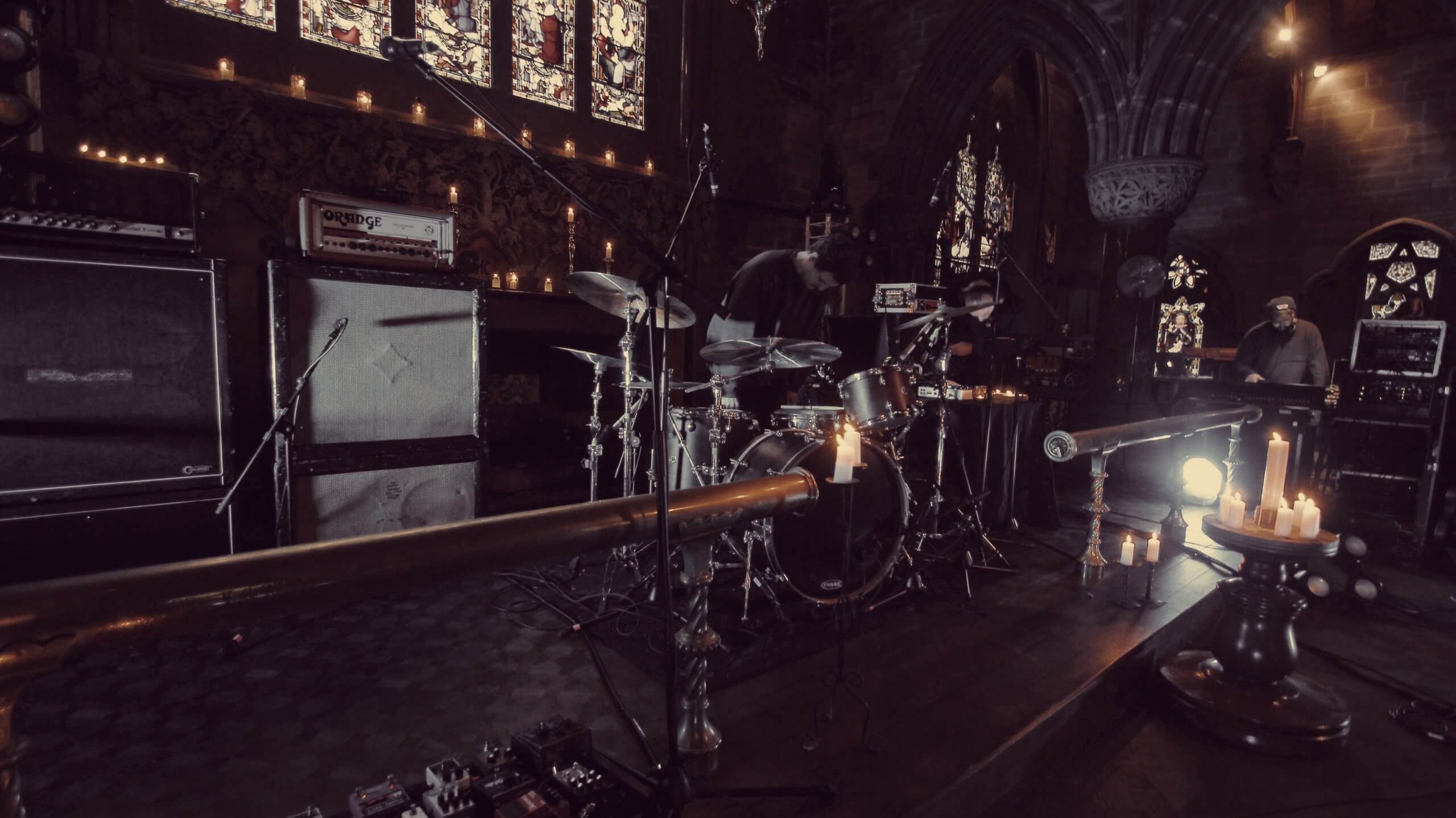
The rest of the mix was generally easier than I had anticipated. I was worried that I was going to have to tackle really troublesome amounts of spill and washiness as my monitoring situation on the day was less than ideal but I found that on the whole it was fairly well controlled. There were the usual problems with cymbal spill in the vocal microphones but with some careful and considered EQ moves I was able to control this. Overall I am pleased with the way it came out, I think if I were to take on something like this again in an environment as large as this church, I would probably not bother with live amps on stage and rather have as quiet a stage as possible.
I think it would just help give the overall mix much more focus and clarity.
You can watch a video of the whole process from the day at the link below including one of the tracks from the final edit and live stream.
For those of you who aren’t aware, Palm Reader are one of the UKs most underrated, heavier Hardcore Punk / Metal bands. They haven’t exactly had the easiest of careers as a band but they have never given in or let anything get the better of them. Three full length records down, they recently released their fourth full length LP “Sleepless” via Church Road Records. Available digitally on all streaming platforms, 12” Vinyl and CD.
Of course, like everyone other artist/band, 2020 has been more than tough for Palm Reader and with the release of their new album and no way to promote it with live shows, they took it upon themselves to create a visual, sonic spectacle to rival all the others that they had seen throughout global lockdowns. The guys asked whether I’d be up for capturing, mixing and mastering the audio for this project and I of course welcomed the offer with open arms.
The session took place over two days at St Edmunds Church in Rochdale, Greater Manchester. After extensive virtual meetings, myself, the Director Sam Lees and the rest of the crew decided that having the additional day would be the best way to tackle any potential issues. Due to not being able to run full production rehearsals until the weekend of the shoot it was important for us that we had enough time to go through everything in situ to iron out any kinks. We spent the entirety of Saturday setting up and running through everything making sure the band had their monitor feeds correct and I was capturing what I needed etc so that on Sunday morning we could just walk in and get started.

In order to keep things as problem free as possible, I made the audio set up as simple as possible without compromising on any quality.
I rented a 48 Channel Stage Splitter so that both myself and Lewis (Monitor Engineer) had our own feeds to work with. This was so both Lewis and myself could handle our own gain staging and Lewis could mix his monitors without affectingany of my feeds.
We ran the backline directly into the stage split and then took our independent feeds from there.
The bands set up was as follows:
– Drums
– Bass (Amp & DI)
– Guitar L (2x Amp & 1x DI)
– Guitar Center (Amp & DI)
– Guitar R (Amp & DI)
– Keys / Modular Synths (L/R DI)
– Lead Vocals
– Backing Vocals (x3)
– Rooms Stereo 2x
– Room Omni x1
With a total channel count of 27. Audient were good enough to send me another ASP880 for this session in order for me to expand my channel capabilities to handle the session.
My rig consisted of my Clarett 8PreX which was hooked into my ASP800 and Octopre Mkii. These three units were connected and synced via ADAT and Wordclock giving me a channel count of 24, I then ran my Audient ID44 with the additional ASP880 Synced via ADAT & Wordclock which once clocked together with the Focusrite units and ASP800 by creating an aggregate device on my Mac gave me a total channel count of 36. This left me with plenty of room to play with if I needed / wanted to add any additional microphones / DIs.
I have made a crude little diagram of this setup so you can understand it better. See below:

In terms of the on stage setup I spent a while going back and forth between having amps live on stage or whether to just take DI’s and not have the amps live then re-amp when I was back in the studio in order to reduce the amount of spill and wash. Recording in a venue like a large empty church poses a lot of problems when it comes to clarity and spill so I wanted to try and reduce this as much as possible to make my life easier when it came to mixing the session. I ended up settling on having the amps live but just quiet in the room. I decided to do this when I decided I wanted to use additional room mics. I didn’t want the room mics to not give an accurate representation of the energy coming off the stage by only having the drums in them. So I took DI signals from the end of the guys pedalboards as well as having the amps live. Typically if I was taking DIs for re-amping I would take them before any effects pedals so I had complete control over the re-amping stage but because this was live and I needed what was coming out of the amps into the room mics to match with whatever got re-amped I needed to make sure that all the guys effects processing was maintained on the DI signal. The final mix is a blend of re-amped DI signals and original on the day live audio straight from the speaker cabinets. Since all the performers were on in-ear monitors, they were able to have clear and detailed monitoring fed directly to them, which meant I was able to run a quieter stage and pose no issue to their performance.
Micing wise I have attached a table of how things were mic’d and below that there is a short walk-through of the positions and how the mics were used.
| Instrument | Mic |
| Kick In | Shure Beta 91a |
| Kick Out | Audix D6 |
| Snare Top | Beyerdynamic M201 |
| Snare Bottom | Sennheiser E604 |
| Rack | Aston Starlight |
| Floor | Audix D6 |
| Hi Hat | Shure SM81 |
| OH L | SE Electronics 5 |
| OH R | SE Electronics 5 |
| GTR L (Vox) | Shure SM57 |
| GTR L (Sunn) | Sennheiser M421 |
| GTR DI | DI |
| GTR C (Orange) | Shure SM57 |
| GTR DI | DI |
| GTR R (Orange) | Shure SM57 |
| GTR DI | DI |
| Bass Amp (Orange) | Shure Beta 52a |
| Bass DI | Darkglass Electronics B7K Ultra |
| Modular Synth (L) | DI |
| Modular Synth (R) | DI |
| Lead Vocal | Shure Beta 58 |
| BV L | Sennheiser E945 |
| BV C | Sennheiser E945 |
| BV R | Sennheiser E945 |
| Room L | SE Electronics X1 |
| Room R | SE Electronics X1 |
| Room Centre (Omni) | Rode NT2a |
When it came to mixing, I spent a couple of days re-amping the guitars and bass parts. The guys were good enough to lend me the amps they used on the day so that my re-amps were as close to the source audio in the church. I used a regular setup for the re-amping, running a Sennheiser 421 and an SM57 on the cabinet and putting these through the first two channels on my Audient ASP800 so I was able to use a blend of the HMX and IRON circuits to add a bit more depth and saturation.
After re-amping it was a typical mix process of balancing the original source audio from the day and then carefully blending the re-amped signals. It was important for myself and the band to not make it sound like we’d filmed the session and then just gone and re-recorded all the audio in a studio so maintaining a sense of live & organic energy was paramount. This is why I made the choice in the mix to not just directly replace the re-amped guitars and instead use a blend of both.

The rest of the mix was generally easier than I had anticipated. I was worried that I was going to have to tackle really troublesome amounts of spill and washiness as my monitoring situation on the day was less than ideal but I found that on the whole it was fairly well controlled. There were the usual problems with cymbal spill in the vocal microphones but with some careful and considered EQ moves I was able to control this. Overall I am pleased with the way it came out, I think if I were to take on something like this again in an environment as large as this church, I would probably not bother with live amps on stage and rather have as quiet a stage as possible.
I think it would just help give the overall mix much more focus and clarity.
You can watch a video of the whole process from the day at the link below including one of the tracks from the final edit and live stream.
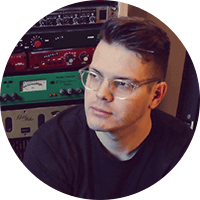
About the author
Hamish Dickinson & Phoenix Sound provides a personal, individually tailored recording experience for musicians and businesses in a beautiful purpose-built studio in Mansfield, Nottinghamshire. Hamish works one-on-one with bands and artists across different genres, producing their albums and E.P.s, from first recording, through mixing and mastering, to the final product.
Our Products
-

Interfaz de audio 2 entradas | 2 salidas
-

10in | 14out Audio Interface
-

Interfaz de audio 10 entradas | 6 salidas
-

Interfaz de audio 20 entradas | 24 salidas
-
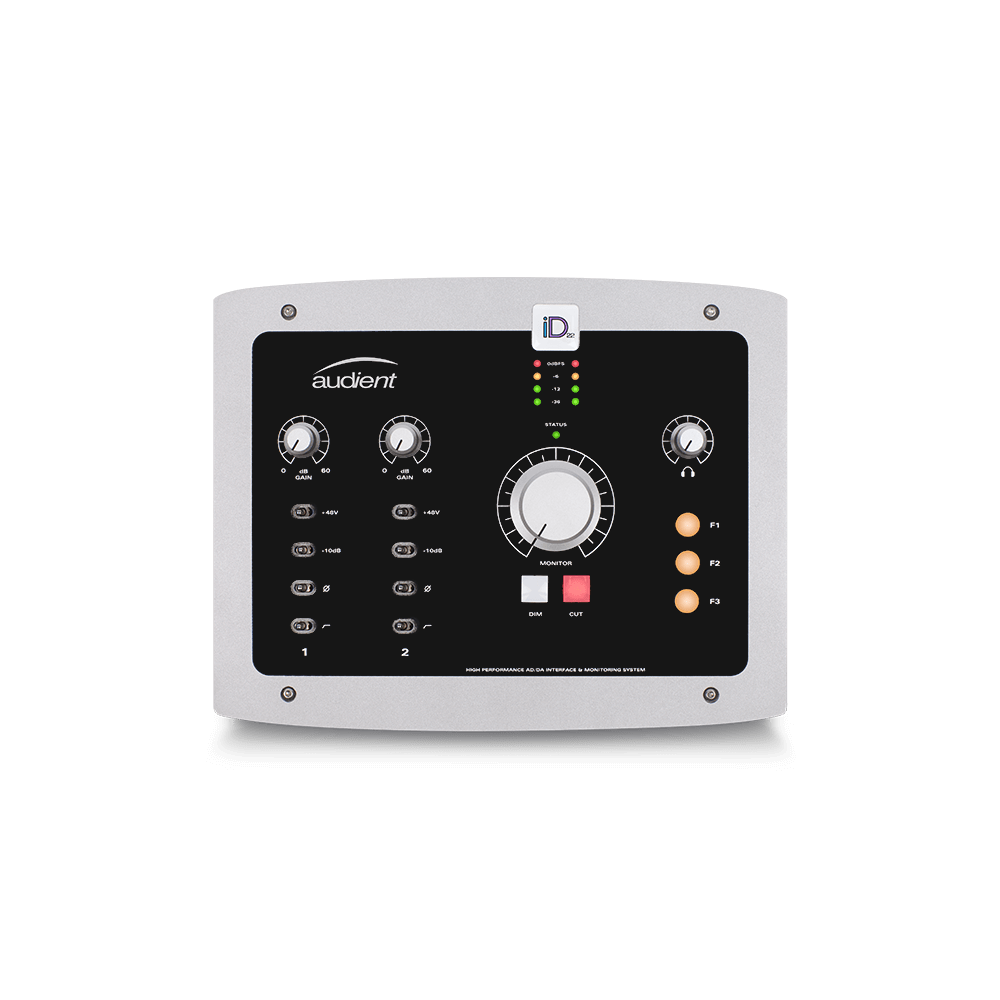
Interfaz de audio 10 entradas | 14 salidas
-

Interfaz de audio 2 entradas | 2 salidas
-

Interfaz de audio 4 entradas | 4 salidas
-

Todo lo que necesitas para empezar a grabar
-

Interfaz de audio 10 entradas | 4 salidas
-

Previo de micro y ADC de 8 canales
-

Previo de micro y control de tono de 8 canales
-

Consola de grabación analógica modular
-

Small Format Analogue Recording Console
-

Small Format Analogue Recording Console
-

Immersive Audio Interface and Monitor Controller
-

Controlador de sobremesa para monitores
-

Controlador de monitores de sonido surround


